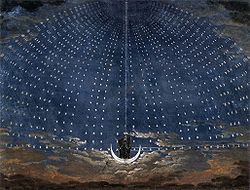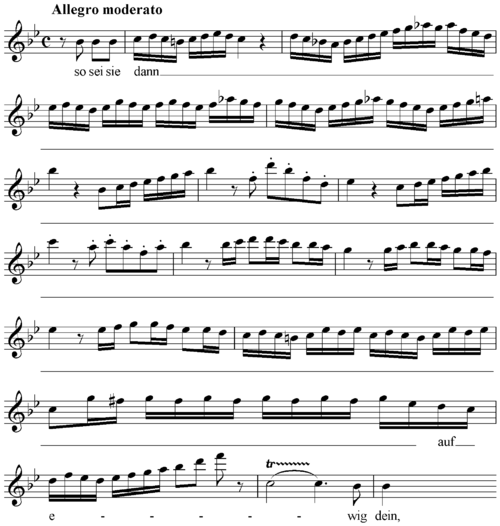
O zittre nicht, mein lieber Sohn
Encyclopedia

Aria
An aria in music was originally any expressive melody, usually, but not always, performed by a singer. The term is now used almost exclusively to describe a self-contained piece for one voice usually with orchestral accompaniment...
performed by the Queen of the Night character (a famous soprano
Soprano
A soprano is a voice type with a vocal range from approximately middle C to "high A" in choral music, or to "soprano C" or higher in operatic music. In four-part chorale style harmony, the soprano takes the highest part, which usually encompasses the melody...
coloratura
Coloratura
Coloratura has several meanings. The word is originally from Italian, literally meaning "coloring", and derives from the Latin word colorare . When used in English, the term specifically refers to elaborate melody, particularly in vocal music and especially in operatic singing of the 18th and...
part) in Mozart's
Wolfgang Amadeus Mozart
Wolfgang Amadeus Mozart , baptismal name Johannes Chrysostomus Wolfgangus Theophilus Mozart , was a prolific and influential composer of the Classical era. He composed over 600 works, many acknowledged as pinnacles of symphonic, concertante, chamber, piano, operatic, and choral music...
singspiel
Singspiel
A Singspiel is a form of German-language music drama, now regarded as a genre of opera...
The Magic Flute
The Magic Flute
The Magic Flute is an opera in two acts composed in 1791 by Wolfgang Amadeus Mozart to a German libretto by Emanuel Schikaneder. The work is in the form of a Singspiel, a popular form that included both singing and spoken dialogue....
. It is not as well known as the Queen's second aria, "Der Hölle Rache kocht in meinem Herzen
Der Hölle Rache kocht in meinem Herzen
"Der Hölle Rache kocht in meinem Herzen" is the second aria sung by a coloratura soprano role Queen of the Night in Mozart's opera The Magic Flute .-The aria:...
", though no less demanding; the aria requires a soprano coloratura with extremely high tessitura
Tessitura
In music, the term tessitura generally describes the most musically acceptable and comfortable range for a given singer or, less frequently, musical instrument; the range in which a given type of voice presents its best-sounding texture or timbre...
and great vocal flexibility.
Significance
The Queen of the Night was one of the first well known roles which demanded a range that until Mozart's time was never called for, and this opened the door for many followers to call for specific kind of singers (lyric, dramatic, coloratura etc.) rather than just "soprano", "tenor" etc.The part, in whole, calls for two arias, O zittre nicht and Der Hölle Rache. The first calls for a rather lyric and flexible voice while the second requires a dramatic and powerful voice. Originally, the part was written for Josepha Hofer
Josepha Weber
Josepha Weber was a German soprano of the classical era...
, the composer's sister-in-law, whose voice possessed both of these qualities. Most modern performers are specialists in either lyric or dramatic style. This, along with the difficulty of the two arias, makes the role of the Queen of the Night one of the most demanding roles in operatic repertoire.
The aria in The Magic Flute
In the preceding scene, Prince Tamino was shown a portrait of the Queen's daughter Pamina and fallen instantly in love with her, singing of his feelings in the aria "Dies Bildnis ist bezaubernd schönDies Bildnis ist bezaubernd schön
Dies Bildnis ist bezaubernd schön is an aria from the 1791 opera Die Zauberflöte by Wolfgang Amadeus Mozart, libretto by Emanuel Schikaneder. The aria comes from Act I, scene I of the opera...
". The Queen then makes a dramatic entrance, preceded by the Three Ladies calling to Tamino "Sie kommt! Sie kommt!" ("[Here] she comes!"). The grand entrance music for the Queen is in B-flat, marked Allegro maestoso, with the following stage direction:
- The mountains [in the scenery] are parted, and the stage is transformed into a magnificent chamber. The Queen is seated on a throne decorated with transparent stars.
Not all modern productions adhere to this prescription.
In the aria, the Queen first quiets Tamino's fears and attempts to befriend him, then tells the sad tale of Pamina's abduction by Sarastro, then finally makes a stirring plea to Tamino to rescue her daughter. As the aria ends, the Queen and the Three Ladies leave the stage, leaving the astonished Tamino to ponder his task and gather his resolve.
Music
The soprano soloist performs with an orchestra consisting of pairs of oboeOboe
The oboe is a double reed musical instrument of the woodwind family. In English, prior to 1770, the instrument was called "hautbois" , "hoboy", or "French hoboy". The spelling "oboe" was adopted into English ca...
s, bassoon
Bassoon
The bassoon is a woodwind instrument in the double reed family that typically plays music written in the bass and tenor registers, and occasionally higher. Appearing in its modern form in the 19th century, the bassoon figures prominently in orchestral, concert band and chamber music literature...
s, horn
Horn (instrument)
The horn is a brass instrument consisting of about of tubing wrapped into a coil with a flared bell. A musician who plays the horn is called a horn player ....
s, and strings
String section
The string section is the largest body of the standard orchestra and consists of bowed string instruments of the violin family.It normally comprises five sections: the first violins, the second violins, the violas, the cellos, and the double basses...
. The three parts of the Queen's discourse are set as musically separate items, each marked by a change in key:
- Recitative (B-flat major) - continues the Allegro maestoso tempo marking of the entrance music, but often performed in free tempo
- First part of the aria (G minorG minorG minor is a minor scale based on G, consisting of the pitches G, A, B, C, D, E, and F. For the harmonic minor scale, the F is raised to F. Its relative major is B-flat major, and its parallel major is G major....
) - Andante - Second part of the aria (back to B-flat major) - Allegro moderato
It is in the third part that the music reaches a high level of virtuosity for the soloist, including the following very difficult coloratura:

The highest note, F
F (musical note)
F is a musical note, the fourth above C. It is also known as fa in fixed-do solfège.When calculated in equal temperament with a reference of A above middle C as 440 Hz, the frequency of Middle F is approximately 349.228 Hz. See pitch for a discussion of historical variations in...
, is claimed by a posthumous witness to have been mentioned by Mozart on his deathbed; the composer was (if the story is true) imagining his sister-in-law's performance. See Death of Mozart
Death of Mozart
The composer Wolfgang Amadeus Mozart died at 1:00 am on 5 December 1791 at the age of 35, following a short illness.-Illness and last days:...
.
Words
The lyrics for the aria were written by the opera's librettistLibretto
A libretto is the text used in an extended musical work such as an opera, operetta, masque, oratorio, cantata, or musical. The term "libretto" is also sometimes used to refer to the text of major liturgical works, such as mass, requiem, and sacred cantata, or even the story line of a...
Emanuel Schikaneder
Emanuel Schikaneder
Emanuel Schikaneder , born Johann Joseph Schickeneder, was a German impresario, dramatist, actor, singer and composer. He was the librettist of Wolfgang Amadeus Mozart's opera The Magic Flute and the builder of the Theater an der Wien...
. Schikaneder was the impresario
Impresario
An impresario is a person who organizes and often finances concerts, plays or operas; analogous to a film producer in filmmaking, television production and an angel investor in business...
for whom the opera was written as well as the first performer of the role of Papageno.
| Original German lyrics | English translation |
|---|---|
| O zittre nicht, mein lieber Sohn! Du bist unschuldig, weise, fromm; Ein Jüngling, so wie du, vermag am besten Dies tiefbetrübte Mutterherz zu trösten. Zum Leiden bin ich auserkoren, Denn meine Tochter fehlet mir; Durch sie ging all mein Glück verloren, Ein Bösewicht entfloh mit ihr. Noch seh ich ihr Zittern Mit bangem Erschüttern, Ihr ängstliches Beben, Ihr schüchternes Streben. Ich musste sie mir rauben sehen, Ach, helft! ach helft! war alles, was sie sprach. Allein vergebens war ihr Flehen, Denn meine Hilfe war zu schwach. Du, du, du wirst sie zu befreien gehen, Du wirst der Tochter Retter sein. Und werd' ich dich als Sieger sehen, So sei sie dann auf ewig dein. |
Oh, tremble not, my dear son! You are innocent, wise, pious; A youth like you must do his best to console this deeply troubled mother's heart. I am chosen for suffering For my daughter is gone from me; Through her all my happiness has been lost, A villain fled with her. I can still see her trembling with fearful shaking, her frightened quaking, her timid effort. I had to see her stolen from me, Oh help! Oh help! was all that she said. But in vain was her pleading, For my powers of help were too weak. You, you, you will go to free her, You will be the rescuer of my daughter. And if I see you return in triumph, Then she will be yours forever. |
There are five quatrain
Quatrain
A quatrain is a stanza, or a complete poem, consisting of four lines of verse. Existing in various forms, the quatrain appears in poems from the poetic traditions of various ancient civilizations including Ancient Greece, Ancient Rome, and China; and, continues into the 21st century, where it is...
s, of which the third is written in amphibrach
Amphibrach
An amphibrach is a metrical foot used in Latin and Greek prosody. It consists of a long syllable between two short syllables. The word comes from the Greek αμφίβραχυς, amphíbrakhys, "short on both sides"....
ic dimeter
Dimeter
In poetry, a dimeter is a metrical line of verse with two feet. Consider Thomas Hood's "Bridge of Sighs:"In poetry, a dimeter is a metrical line of verse with two feet. Consider Thomas Hood's "Bridge of Sighs:"...
and the remaining ones in iambic tetrameter
Iambic tetrameter
Iambic tetrameter is a meter in poetry. It refers to a line consisting of four iambic feet. The word "tetrameter" simply means that there are four feet in the line; iambic tetrameter is a line comprising four iambs...
, which is the normal meter for The Magic Flute. Mozart repeats the words "Ach, helft!" ("Oh, help!") and "Du" ("you", thrice), so the lines with these words are not iambic tetrameters as they are actually sung. The rhyme scheme is [AABB][CDCD][EEFF][GHGH][IJIJ].

